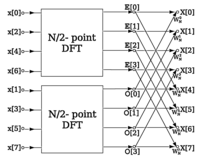
Photo from wikipedia
The bioelectrical signals that produce uterine contractions during parturition are not completely understood. The objectives are as follows: (1) to review the literature and information concerning uterine biopotential waveforms generated… Click to show full abstract
The bioelectrical signals that produce uterine contractions during parturition are not completely understood. The objectives are as follows: (1) to review the literature and information concerning uterine biopotential waveforms generated by the uterus, known to produce contractions, and evaluate mechanotransduction in pregnant patients using electromyographic (EMG) recording methods and (2) to study a new approach, uterine vector analysis, commonly used for the heart: vectorcardiography analysis. The patients used in this study were as follows: (1) patients at term not in labor (n = 3); (2) patients during the 1st stage of labor at cervical dilations from 2 to 10 cm (n = 30); and (3) patients in the 2nd stage of labor and during delivery (n = 3). We used DC-coupled electrodes and PowerLab hardware (model no. PL2604, ADInstruments, Castle Hill, Australia), with software (LabChart, ADInstruments) for storage and analysis of biopotentials. Uterine and abdominal EMG recordings were made from the surface of each patient using 3 electrode pairs with 1 pair (+ and −, with a 31-cm spacing distance) placed in the right/left position (X position) and with 1 pair placed in an up/down position (Y position, also 31 cm apart) and with the third pair at the front/back (Z position). Using signals from the three X, Y, and Z electrodes, slow (0.03 to 0.1 Hz, high amplitude) and fast wave (0.3 to 1 Hz, low amplitude) biopotentials were recorded. The amplitudes of the slow waves and fast waves were significantly higher during the 2nd stage of labor compared to the 1st stage (respectively, p = 9.54 × e−3 and p = 3.94 × e−7). When 2 channels were used, for example, the X vs. Y, for 2-D vector analysis or 3 channels, X vs. Y vs. Z, for 3-D analysis, are plotted against each other on their axes, this produces a vector electromyometriogram (EMMG) that shows no directionality for fast waves and a downward direction for slow waves. Similarly, during the 2nd stage of labor during abdominal contractions (“pushing”), the slow and fast waves were enlarged. Manual applied pressure was used to evoke bioelectrical activity to examine the mechanosensitivity of the uterus. Conclusions: (1) Phasic contractility of the uterus is a product of slow waves and groups of fast waves (bursts of spikes) to produce myometrial contractile responses. (2) 2-D and 3-D uterine vector analyses (uterine vector electromyometriogram) demonstrate no directionality of small fast waves while the larger slow waves represent the downward direction of biopotentials towards the cervical opening. (3) Myometrial cell action event excitability and subsequent contractility likely amplify slow wave activity input and uterine muscle contractility via mechanotransduction systems. (4) Models illustrate the possible relationships of slow to fast waves and the association of a mechanotransduction system and pacemaker activity as observed for slow waves and pacemakers in gastrointestinal muscle. (5) The interaction of these systems is thought to regulate uterine contractility. (6) This study suggests a potential indicator of delivery time. Such vector approaches might help us predict the progress of gestation and better estimate the timing of delivery, gestational pathologies reflected in bioelectric events, and perhaps the potential for premature delivery drug and mechanical interventions.
Journal Title: Reproductive Sciences
Year Published: 2020
Link to full text (if available)
Share on Social Media: Sign Up to like & get
recommendations!